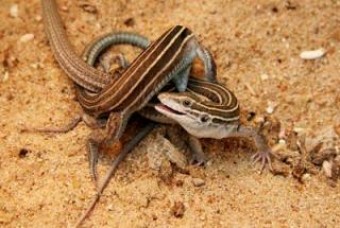New Mexico Whiptail Lizards are All Females
 Today I found out New Mexico Whiptail lizards are all females.
Today I found out New Mexico Whiptail lizards are all females.
While this isn’t completely unheard of among various life forms on Earth, such as with certain plants, insects, and sea life, among others, what is particularly interesting is how the New Mexico Whiptail lizards go about reproducing. To do this, they will generally perform a type of pseudocopulation where two females will act out having sex as if one was a male.
While not strictly required to reproduce, this simulated sex has been shown to increase the fertility of the particular lizards acting out copulation, producing more eggs than those who don’t. Also of interest is that the lizard acting out the female role on bottom will produce bigger eggs than the one acting out the male role. Who gets to be on top or bottom is alternated from mating season to mating season, with those who acted out the male part one season, switching to act out the female part the next, and vice-versa.
Despite no external fertilization, the offspring of the lizards are not actually perfect clones of one another. Rather, recent research by doctoral student Aracely Lutes at Baumann Lab has shown that the New Mexico Whiptail lizard produces twice the number of chromosomes as other types of Whiptail lizards which mate normally. A process of recombination of these chromosomes then occurs, somewhat similar to what happens in normal male/female pairings, which then produces genetically diverse offspring.
If you liked this article, you might also enjoy our new popular podcast, The BrainFood Show (iTunes, Spotify, Google Play Music, Feed), as well as:
- The Bizarre World of Animal Reproduction
- Camel Humps are Not Filled with Water
- 10 Wild and Wacky Animal Mating Rituals
- Ostriches Don’t Hide Their Heads in the Sand
- Before Mating, the Female Giraffe Will Urinate in the Male’s Mouth
Bonus Facts:
- “Parthenogenesis”, which is the technical name for how the New Mexico Whiptail lizards reproduce, comes from the Greek “parthenos”, meaning “virgin”, and “genesis”, meaning “birth”.
- Komodo dragons; hammerhead sharks; brahminy blind snakes; water fleas; certain types of bees, scorpions, wasps, and even some types of birds, among others, are among other animal species that are capable of reproducing asexually, if necessary.
- The first documented case of a hammerhead shark reproducing asexually happened on December 14, 2001 at the Henry Doorly Zoo in Nebraska where a female hammerhead shark, which was kept in isolation from males, miraculously gave birth to a pup. The pup was unfortunately killed by a stingray shortly thereafter, but testing showed that the pup was, in fact, a child of only its mother, though not a perfect clone, containing only half of its mother’s DNA. This made it the first documented case of a cartilaginous fish reproducing this way.
- The New Mexico Whiptail lizard is the state reptile of New Mexico, though it can also be found in Arizona as well as Northern Mexico.
- New Mexico Whiptail lizards typically rely on their speed and hiding in vegetation to avoid predators. They eat various insects and other such creatures they can find on the ground. They can also dig into the ground to find food. Full grown, they tend to measure around 6-9 inches long.
- Another form of asexual reproduction similar to parthenogenesis is called “gynogenesis”. In gynogenesis, the process is more or less exactly the same as parthenogenesis except the egg does require the presence of sperm in order to trigger development, though the sperm itself doesn’t contribute its genetic code to the offspring. In these cases, the sperm is generally from another species of animal, such that the sperm couldn’t contribute its genetic code. Certain types of salamanders, among others, exhibit gynogenetic reproduction.
| Share the Knowledge! |
|





2 comments